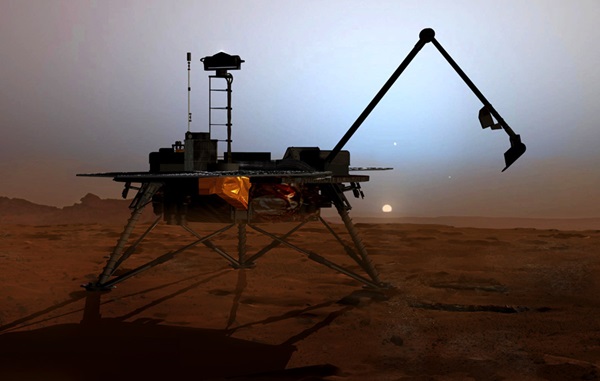Key Takeaways:
In 1976, the twin landers of the Viking armada touched down and began to scoop and sniff the martian soil for signs of life. But because of the way the landers’ onboard laboratories conducted the search for living organisms, they may have inadvertently baked and drowned any life they found.
At least that’s what two scientists argued Sunday, January 7, at a meeting of the American Astronomical Society (AAS) in Seattle. Dirk Schulze-Makuch of Washington State University in Pullman and Joop Houtkooper of Justus Liebig University in Giessen, Germany, propose that the findings of the experiments conducted aboard the Viking landers can be explained if one assumes a different kind of biochemical basis for life than the one we are used to: one based on a mixture of water and hydrogen peroxide, not the salty water that fills the cells of most earthly life. Schulze-Makuch and Houtkooper assert the findings of all four Viking life-detection experiments are consistent with hydrogen-peroxide-based microbes.
Also, the researchers point out, life based on a mix of hydrogen peroxide and water makes more sense practically speaking. Hydrogen peroxide mixed with water remains in a fluid state down to –68° F (–56° C) — a helpful property in the frigid martian atmosphere. Hydrogen-peroxide also has the ability to attract water vapor from the extremely dry martian air.
Ultimately, Schulze-Makuch and Houtkooper contend, the Viking landers failed to detect life because they were searching for the wrong kind of life. Moreover, at least two of the Viking experiments would have killed off any hydrogen-peroxide-based organisms in the soil. One experiment required adding water to soil samples, which would have drowned the hydrogen-peroxide bugs. Another test involved heating the soil samples — also deadly to the organisms Schulze-Makuch and Houtkooper propose.
Sounds intriguing, but is it true? The next opportunity to gather hard evidence for the hydrogen-peroxide hypothesis will be May 2008. That’s when the Phoenix lander is slated to touch down in Mars’ arctic region. The lander’s gear includes an onboard chemical laboratory that should be able to detect organic compounds produced by martian microorganisms, either living or long-dead.
“If there’s life in the soil, we’d be able to detect it,” says Christopher Shinohara, manager of the Phoenix mission’s science operations center at the University of Arizona, Tucson. The Phoenix mission is based at the University of Arizona’s Lunar and Planetary Laboratory.
Christopher McKay, another member of the Phoenix team, says he encouraged Schulze-Makuch to come up with a specific test of his hypothesis using the lander’s current configuration, because it’s too late in the mission to change any of the instruments. For example, McKay says, they might use the craft’s oven-like Thermal and Evolved Gas Analyzer (TEGA) to heat a soil sample to the temperature at which a water-hydrogen peroxide mix should decompose into its chemical constituents. If it decomposes as predicted, the TEGA should be able to detect it. This, McKay says, would not prove Schulze-Makuch’s hypothesis conclusively, “but it would certainly pique interest.”










